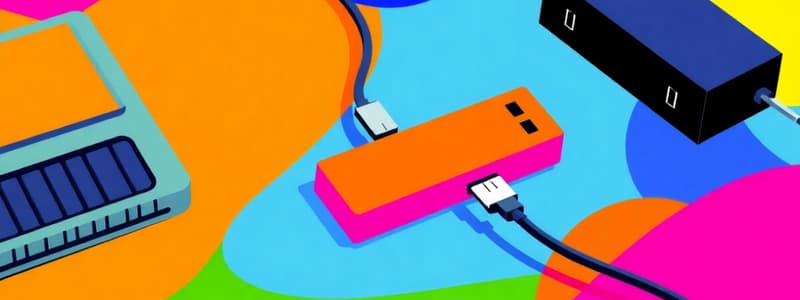Podcast
Questions and Answers
Which of the following input devices is typically used to enter data through touch?
Which of the following input devices is typically used to enter data through touch?
- Monitor
- Stylus (correct)
- Mouse
- Printer
What is a key advantage of a laser printer compared to an inkjet printer?
What is a key advantage of a laser printer compared to an inkjet printer?
- Higher-quality printouts (correct)
- Compact size
- Better color accuracy
- Lower initial cost
When considering image output devices, which of the following provides a means to display pictures?
When considering image output devices, which of the following provides a means to display pictures?
- Monitor (correct)
- Microphone
- Printer
- Speaker
Which type of printing device is specifically designed to create three-dimensional objects?
Which type of printing device is specifically designed to create three-dimensional objects?
What is a characteristic of cloud-ready printers?
What is a characteristic of cloud-ready printers?
Which of the following options describes a common type of data storage device?
Which of the following options describes a common type of data storage device?
What is the main function of a CPU in a computer system?
What is the main function of a CPU in a computer system?
Which of the following options is NOT a method for outputting images from a computer?
Which of the following options is NOT a method for outputting images from a computer?
Which data storage option is typically used for large volumes of data due to its high capacity?
Which data storage option is typically used for large volumes of data due to its high capacity?
What is the primary storage device commonly used in computers?
What is the primary storage device commonly used in computers?
What type of storage allows files to be saved on the Internet?
What type of storage allows files to be saved on the Internet?
What is one of the characteristic features of a solid-state drive (SSD)?
What is one of the characteristic features of a solid-state drive (SSD)?
How does the number of CPU cores affect processing performance?
How does the number of CPU cores affect processing performance?
Which of the following is an example of a local storage device?
Which of the following is an example of a local storage device?
What aspect of a CPU does the term gigahertz (GHz) refer to?
What aspect of a CPU does the term gigahertz (GHz) refer to?
Which type of port enables data transfer speeds of 10 Gbps?
Which type of port enables data transfer speeds of 10 Gbps?
Flashcards are hidden until you start studying
Study Notes
Input Devices
- Physical devices for data entry include keyboards, touch screens, styluses, and virtual keyboards.
- Common pointing devices are mice, touch pads (trackpads), and game controllers.
- For image input, devices such as digital cameras, camcorders, mobile device cameras, flatbed scanners, and webcams are widely used.
- Sound input is commonly achieved through microphones paired with voice recognition software, along with various sensor technologies.
Output Devices
- Output devices transmit data from computers in forms such as text, images, sounds, and video.
- Monitors, printers, and speakers/headphones are typical output devices.
- Display screen types include Liquid Crystal Display (LCD), Light-Emitting Diode (LED), and Organic Light-Emitting Diode (OLED).
- Key features of display technology include pixels, aspect ratio, and resolution for visual display quality.
- Speakers provide sound output, with options for surround sound and wireless systems, while earbuds can pose a risk of hearing damage from excessive volume.
Printers
- Inkjet printers are affordable, produce high-quality color prints, and operate quickly and quietly.
- Laser printers offer faster speeds and higher-quality prints, but are generally more costly.
- Cloud-ready printers can connect to the internet, while all-in-one printers combine printing, scanning, copying, and faxing capabilities.
- Large format printers specialize in oversize image printing, and 3D printers create three-dimensional objects.
The Motherboard and Memory
- The motherboard contains the CPU, ROM, RAM, cache, and slots for expansion cards, such as sound/video cards and network interface cards (NIC).
- The Central Processing Unit (CPU) is the "brain" of the computer, controlling functions and processing commands at speeds measured in gigahertz (GHz), which indicates billions of tasks per second.
CPU Performance
- CPU performance metrics include processor speed (measured in hertz, with gigahertz being a common standard) and the number of cores, ranging from single to multi-core configurations (dual, quad, and more).
Storage Options
- Local storage devices like Hard Disk Drives (HDD) are nonvolatile and include internal and external drives, while Solid-State Drives (SSD) provide faster access speeds.
- Portable storage options encompass flash drives and memory cards.
- Cloud storage allows file access via the internet, often with a free tier available and additional purchase options for extra space.
Ports and Connectivity
- Thunderbolt ports enable data transfer speeds up to 40 Gbps, while USB ports can reach speeds of 10 Gbps.
- Ethernet ports allow high-speed internet connectivity, up to 10,000 Mbps, and HDMI ports provide video and audio connections.
Power Management
- Various power management techniques include monitoring battery drain, using sleep mode, and differentiating between warm/cold boots and hibernate states.
Computer Functions
- A computer performs four primary functions: input (data gathering), processing (manipulation and calculation), output (data display), and storage (data saving).
Binary Language
- Computers utilize binary as their language, with bits representing the smallest unit (0 or 1) and bytes consisting of 8 bits; larger units include kilobytes, megabytes, gigabytes, terabytes, and petabytes.
Types of Computers
- Common types of computers include cell phones, tablets, laptops, and stationary computers, each designed for specific uses and versatility.
Studying That Suits You
Use AI to generate personalized quizzes and flashcards to suit your learning preferences.




